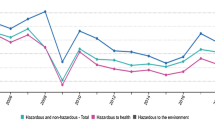Abstract
To determine the toxicological effects of complex mixtures of pesticides, we obtained data on 100 pesticide residues in common food. of central Italy. Fifteen pesticides were more regularly detected at higher levels (dithiocarbamates, benomyllcarbendazim, thiabendazole, diphenylamine, chlorthalonil, procymidone, fenarimol, chlorpropham, vinchlozolin, methidathion, chlorpyriphos-ethyl, parathion-methyl, parathion, chlorfenviphos, pirimiphos-ethyl). Using itemized data on daily food consumption in Italy, we calculated that the average exposure for an adult subject was 716 μg/day, ranging fiom 148 μg of dithiocarbamates to 1 pg of pirimiphos-ethyl. We made a mixture of these 15 pesticides at concentrations proportional to the ratio determined in foods and tested it with the Salmonellamicrosome assay, with and without metabolic activation with PCB-induced rat liver S9. No mutagenic activity was observed at concentrations up to 500 μg/plate. We also tested the same mixture at concentrations ranging from 0.1 to 20 μg/ml on human lymphocytes in vitro, and observed a slight but statistically significant increase in sister-chromatid exchanges at 1 μg/ml. We also administered the mixture in corn oil by gavage to Wistar rats at doses of 1, 10, and 100 μg/kg. After 24 hr the ratio between bone marrowpolychromatic and normochromatic lymphocytes (a sign of cellular toxicity) was decreased by the exposure, but we did not observe a significant increase in the frequency of micronuclei. We conclude that thepesticide mixture did not have appreciablegenotoxic activity in the assays used.
Similar content being viewed by others
Abbreviations
- SCE:
-
sister-chromatid exchanges
References
AMES, B.N., MCCANN, J., and YAMASAKI, E. (1975). “Methods for detecting carcinogens and mutagens with the salmonella-mammalian microsome mutagenicity test.” Mutat. Res. 31: 347–364.
BARALE, R., MARRAZZINI, A., BETTI, C., VANGELISTI, V., LOPRIENO, N., and BARRAI, I. (1990). “Genotoxicity of two metabolites of benzene: phenol and hydroquinone show a strong synergistic effect in vivo.” Mutat. Res. 244: 15–20.
BEHERA, B.C., and BHUNYA, S.P. (1989). “Studies on the genotoxicity of asataf (acephate), an organophosphate insecticide, in a mammalian in vivo system.” Mutat. Res. 223: 287–293.
BUIATTI, E., PALLI, D., DECARLI, A., AMADORI, D., AVELLINI, C., BIANCHI, S., BONAGURI, C., CIPRIANI, F., COCCO, P., and GIACOSA, P. (1990). “A case control study of gastric cancer in Italy. Association with nutrients.” Int. J. Cancer 45: 896–901.
CHIESARA, E., ARNOLDI, A., COVA, D., and RIZZI, R. (1982). “Detection of mutagenicity of vinchlozolin and its epoxide.” Arch. Toxicol. (Suppl.) 5: 345–348.
DE FERRARI, M., ARTUSO, M., BONASSI, S., BONATTI, S., CAVALIERI, Z., PESCATORE, D., MARCHINI, E., PISANO, V., and ABBONDANDOLO, A. (1991). “Cytogenetic biomonitoring of an Italian population exposed to pesticides: chromosome aberrations and sister chromatid exchange analysis in peripheral blood lymphocytes.” Mutat. Res. 260: 105–113.
DOLARA, P., SALVADORI, M., CAPOBIANCO, T., and TORRICELLI, F. (1992). “Sister chromatid exchanges in human lymphocytes induced by dimethoate, omethoate, deltamethrin, benomyl and their mixture.” Mutat. Res. Letters, 283: 113–118.
Epa (1985). Pesticide Fact Sheet. “Fenarimol,” Tox. Chem. n 207AA of 17/6/1985. US Environmental Protection Agency.
GARRET, N.E., STACK, H.F., and WATERS, M. (1986). “Evaluation of the genetic activity profiles of 65 pesticides.” Mutat. Res. 168: 301–325.
GEORGOPOULOS, S.G., SARRIS, M., and ZIOGAS, B.N. (1979). “Mitotic instability in Aspergillus nidulans caused by the fungicides iprodione, procymidone and vinchlozolin.” Pesticide Sci. 10: 389–392.
GONZALEZ CID, M., DORA, L., and MATOS, E. (1988). “Nitroso-aldicarb induces sister chromatid exchanges in human lymphocytes in vitro.” Mutat. Res. 204: 665–668.
GROVER, I.S., and MALHI, P.K. (1985). “Genotoxic effect of some organophosphorus pesticides.” Mutat. Res. 155: 131–134.
HAYATSU, H., ARIMOTO, S., and NEGISHI, T. (1988). “Dietary inhibitors of mutagenesis and carcinogenesis.” Mutat. Res. 202: 429–446.
ISHIDATE, M. Jr., HARNOIS, M.C., and SOFUNI, T. (1988). “A comparative analysis of data on the clastogenicity of 951 chemical substances tested in mammalian cell cultures.” Mutat. Res. 195: 151–213.
MACGREGOR, J.T., HEDDLE, J.A., HITE, M., MARGOLIN, B.H., RAMEL, C. SALAMONE, M.F., TICE, R.R., and WILD, D. (1987). “Guidelines for the conduct of micronucleus assay in mammalian bone marrow erythrocytes.” Mutat. Res. 189: 103–112.
MUDRY DE PARGAMENT, M.D., LABAL DE VINUESA, M., and ARRIPA, I. (1987). “Mutagenic bioassay of certain pharmacological drugs. I. Thiabendazole (TBZ).” Mutat. Res. 188: 1–6.
MURLI, H.S.M., GALLOWAY, J.L., IVETT, D.M., PARRY, and MULVIHILL, L. (1988). “Repair of sister chromatid exchange-inducing lesions in mutagen-treated cultures of human whole blood and purified fresh or frozen lymphocytes. Mutat. Res. 202: 125–132.
PEROCCO, P., COLACCI, A., and GRILLI, S. (1993). “In vitro cytotoxic and cell transforming activities exerted by the pesticides cyanazine, dithianon, diflubenzuron, procymidone, and vinchlozolin on BALB/c 3T3 cells.” Environ. Mol. Mutagen. 21: 81–86.
QUEST, J.A., COPLEY, M.P., HAMERNIK, K.L., RINDE, E., FISHER, B., ENGLER, R., BERNEM, W., and FENNER CRISP, P.M. (1990). “Evaluation of the carcinogenic potential of pesticides. 2. Methidathion.” Reg. Toxicol. Pharmacol. 12: 117–126.
SAILER, J.P. (1973). “The mutagenicity of benzimidazole and benzimidazole derivatives. I. Forward mutations in Salmonella typhimurium caused by benzimidazole and some of its derivatives.” Mutat. Res. 15: 273–276.
SHELBY, M.D. (1988). “The genetic toxicity of human carcinogens and its implications.” Mutat. Res. 204: 3–15.
SOBTI, R.C., KRISHAN, A., and DAVIES, J. (1983). “Cytokinetic and cytogenetic effect of agricultural chemicals on human lymphoid cells in vitro.” Arch. Toxicol. 52: 221–231.
SOHEIR, M., and EZZAT, I.A. (1985). “Cytogenetic effects of pesticides. III. Inductions of micronuclei in mouse bone marrow by the insecticide cypermethrin and rotenone.” Mutat. Res. 155: 135–142.
SUGIMURA, T., KAWAKI, T., NAGAO, M., YAMADA, M., TAKAYAMA, S., MATSUKURA, N., and WAKABAYASHI, K. (1980). “Genotoxic carcinogens and comutagens in tryptophan pyrolysate.” In: Biochemical and Medical Aspects of Tryptophan Metabolism (O. Hayaishi, Y. Ishimura and R. Kido, eds.) Elsevier-North Holland Biomedical Press, Amsterdam. pp. 297–310.
Author information
Authors and Affiliations
Rights and permissions
About this article
Cite this article
Dolara, P., Vezzani, A., Caderni, G. et al. Genetic toxicity of a mixture of fifteen pesticides commonly found in the Italian diet. Cell Biol Toxicol 9, 333–343 (1993). https://doi.org/10.1007/BF00754461
Issue Date:
DOI: https://doi.org/10.1007/BF00754461




